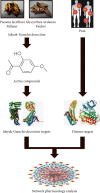An Investigation of the Molecular Mechanisms Underlying the Analgesic Effect of Jakyak-Gamcho Decoction: A Network Pharmacology Study
- PMID: 33343676
- PMCID: PMC7732394
- DOI: 10.1155/2020/6628641
An Investigation of the Molecular Mechanisms Underlying the Analgesic Effect of Jakyak-Gamcho Decoction: A Network Pharmacology Study
Abstract
Herbal drugs have drawn substantial interest as effective analgesic agents; however, their therapeutic mechanisms remain to be fully understood. To address this question, we performed a network pharmacology study to explore the system-level mechanisms that underlie the analgesic activity of Jakyak-Gamcho decoction (JGd; Shaoyao-Gancao-Tang in Chinese and Shakuyaku-Kanzo-To in Japanese), an herbal prescription consisting of Paeonia lactiflora Pallas and Glycyrrhiza uralensis Fischer. Based on comprehensive information regarding the pharmacological and chemical properties of the herbal constituents of JGd, we identified 57 active chemical compounds and their 70 pain-associated targets. The JGd targets were determined to be involved in the regulation of diverse biological activities as follows: calcium- and cytokine-mediated signalings, calcium ion concentration and homeostasis, cellular behaviors of muscle and neuronal cells, inflammatory response, and response to chemical, cytokine, drug, and oxidative stress. The targets were further enriched in various pain-associated signalings, including the PI3K-Akt, estrogen, ErbB, neurotrophin, neuroactive ligand-receptor interaction, HIF-1, serotonergic synapse, JAK-STAT, and cAMP pathways. Thus, these data provide a systematic basis to understand the molecular mechanisms underlying the analgesic activity of herbal drugs.
Copyright © 2020 Ho-Sung Lee et al.
Conflict of interest statement
The authors declare that there are no conflicts of interest.
Figures





Similar articles
-
Orthogonal array design for optimizing extraction efficiency of active constituents from Jakyak-Gamcho Decoction, the complex formula of herbal medicines, Paeoniae Radix and Glycyrrhizae Radix.J Ethnopharmacol. 2007 Sep 5;113(2):306-11. doi: 10.1016/j.jep.2007.06.013. Epub 2007 Jul 3. J Ethnopharmacol. 2007. PMID: 17681441
-
Jakyak-gamcho-tang, a decoction of Paeoniae Radix and Glycyrrhizae Radix et Rhizoma, ameliorates dexamethasone-induced muscle atrophy and muscle dysfunction.Phytomedicine. 2024 Jan;123:155057. doi: 10.1016/j.phymed.2023.155057. Epub 2023 Sep 3. Phytomedicine. 2024. PMID: 37984121
-
A study of the therapeutic mechanism of Jakyakgamcho-Tang about functional dyspepsia through network pharmacology research.Int J Med Sci. 2022 Oct 17;19(13):1824-1834. doi: 10.7150/ijms.77451. eCollection 2022. Int J Med Sci. 2022. PMID: 36438925 Free PMC article.
-
A Pharmacological Review of Bioactive Constituents of Paeonia lactiflora Pallas and Paeonia veitchii Lynch.Phytother Res. 2016 Sep;30(9):1445-73. doi: 10.1002/ptr.5653. Epub 2016 Jun 9. Phytother Res. 2016. PMID: 27279421 Review.
-
The Role of Th17/Treg Axis in the Traditional Chinese Medicine Intervention on Immune-Mediated Inflammatory Diseases: A Systematic Review.Am J Chin Med. 2020;48(3):535-558. doi: 10.1142/S0192415X20500275. Epub 2020 Apr 29. Am J Chin Med. 2020. PMID: 32345031
Cited by
-
Network Pharmacology and In vitro Experimental Verification to Explore the Mechanism of Chaiqin Qingning Capsule in the Treatment of Pain.Curr Pharm Des. 2024;30(4):278-294. doi: 10.2174/0113816128280351240112044430. Curr Pharm Des. 2024. PMID: 38310568
-
Repeated psychological stress, chronic vicarious social defeat stress, evokes irritable bowel syndrome-like symptoms in mice.Front Neurosci. 2022 Oct 6;16:993132. doi: 10.3389/fnins.2022.993132. eCollection 2022. Front Neurosci. 2022. PMID: 36277999 Free PMC article.
-
East Asian Herbal Medicine to Reduce Primary Pain and Adverse Events in Cancer Patients : A Systematic Review and Meta-Analysis With Association Rule Mining to Identify Core Herb Combination.Front Pharmacol. 2022 Jan 17;12:800571. doi: 10.3389/fphar.2021.800571. eCollection 2021. Front Pharmacol. 2022. PMID: 35111066 Free PMC article. Review.
References
LinkOut - more resources
Full Text Sources
Research Materials
Miscellaneous

